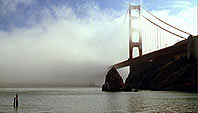The Bridge Review
By Joe Lozito
Troubled Over Bridged Waters
San Francisco's Golden Gate Bridge has the dubious honor of being the most suicide-y structure in North America. More people go there to end their lives than any other. What it is that draws people to this landmark and what happens once they get there is the topic of Eric Steel's darkly fascinating but ethically questionable documentary "The Bridge". For the entirety of 2004, Mr. Steel and his crew set up (manned and unmanned) cameras and filmed nearly every daylight hour. During that time they caught on camera 12 suicides (of the 24 that year) and many more attempts. The footage, which includes many close-up shots of people jumping to their deaths, is, to say the very least, harrowing.
Over the course of the film, we hear from some attemptees and relatives of the deceased. The stories each contain similar notes of desperation - a feeling of disconnectedness with friends and family - but the film is rarely repetitive. What's stunning is the variety of stories Mr. Steel is able to cull together and the access he has to the survivors. Some suffered from chronic depression, some were at the end of their rope, some simply could find no solace in this life.
There is some mystique to the Golden Gate Bridge. Certainly, the ease of access (the pitiful guardrail is a scant four feet high) is one thing, but there's something else about it. In one particularly painful voice-mail message we hear a man who has just been broken up with. Crying, wandering the city, he realizes he's headed for the bridge. He doesn't know why, it just makes sense to go there. Something about it beckons him. And he is not alone.
There's Gene, the film's one through-line. Over the course of the film, Mr. Steel revisits footage of Gene, long black hair blowing in the bay wind, furiously pacing the pedestrian walkway. Gene's friends recount his steady decline into despair, his continual calls to "just kill me now" which they eventually were force to tune out.
Then there's Kevin Hines, who astoundingly survived the fall, deciding in midair that he'd made a mistake. His miraculous story offers a rare glimpse into that last desperate moment. Kevin remembers standing for 40 minutes on the bridge crying, amazed that no single person reached out to help him.
In the film's most memorable moment there is a glimmer of hope. A photographer watches as a woman climbs over the rail. He takes pictures as she readies herself for the plunge. Finally, realizing what he's witnessing, he reaches over, grabs her by the shirt and pulls her back, holding her down until the police arrive.
These are just a few of the stories told in Mr. Steel's fascinating but troubling film. Throughout "The Bridge" there's the nagging knowledge that a film crew was there watching, almost clinically, as people ended their lives. Mr. Steel - who has said that his goal was to convince the San Francisco Bridge Authority to construct a suicide barrier - draws no conclusions during the film. There's no need to. It's difficult enough to watch the footage of people falling to their deaths and to hear the stories of loneliness and ultimate despair. It's hard to call "The Bridge" a good film or even a good documentary. It's hard to recommend it. It is certainly not for the feint of heart. But it is fascinating glimpse into that darkest of places for those willing to take the leap.
